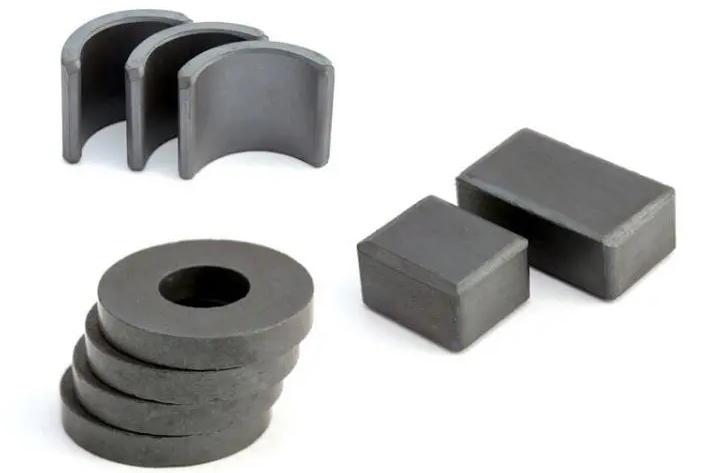
What Are Ferrite Magnets? Frequently asked Questions about Ferrite
Ferrite magnet is a strong magnetic body made of ferrite material, which has high magnetic induction and good resistance to magnetic corrosion. It is one of the most widely used magnetic materials in industrial production, and is widely used in motors, sensors, electronic equipment, medical equipment, aerospace and other fields.

1. Is a ferrite magnet a ceramic magnet?
The Ferrite permanent magnet is also known as a Ceramic Magnet and even as hard ferrite magnet. The name is interchangeable but they all refer to exactly the same material type. They are known as Ceramic Magnets because they are electrically insulating.
2. What are ferrite magnets made of?
Ferrite Magnets (Ceramic Magnets) are produced by calcining (at between 1000 to 1350 degrees C) a mixture of iron oxide (Fe2O3) and strontium carbonate (SrCO3) or barium carbonate (BaCO3) to form a metallic oxide.
3. What type of magnet is a ferrite magnet?
Ferrite magnets, also known as ceramic magnets are a type of permanent magnet and are made of the chemical compound ferrite, which consists of ceramic materials and iron oxide (Fe2O3), the chemical composition is SrO-6(Fe2O3).
4. What is the difference between a ferrite magnet and a neodymium magnet?
The key difference between neodymium and ferrite magnets is that neodymium magnet contains neodymium, iron and boron as the major components whereas ferrite magnets have iron as the major component. Rare earth magnets are strong, permanent magnets. Ferrite magnets are not that much strong.
5. What is the difference between ferrite magnets and alloy magnets?
The main difference between these two types of magnets is that rare earth magnets are made from rare earth alloys, and ferrite magnets are mainly composed of iron.
6. Do ferrite magnets rust?
Ferrite magnets, also known as ceramic magnets, are made from iron-oxide and as a result they simply do not corrode even when submerged in water.
7. Do ferrite magnets lose their magnetism?
This resistance to changes to the magnetic field is called coercivity. Neodymium magnets have more coercivity than ferrite ones. Even a ferrite permanent magnet will not lose much of its magnetization over time.
8. What are the properties of ferrite?
A strong magnetic property, relatively low conductivity, low eddy current and dielectric losses, and high permeability are the important properties of ferrite materials.
9. What is the maximum temperature for a ferrite magnet?
Ferrite magnets can be used at temperatures up to a maximum of +250 degrees C (in a few situations perhaps up to +300 degrees C).
10. What are the different grades of ferrite magnets?
The two main grades used today are C5 (also known as Feroba2, Fer2, Y30 and HF26/18) and C8 (also known as Feroba3, Fer3 and Y30H-1). C 5 / Y30 is a general choice of Ferrite Magnet for applications such as overband magnets.
11. What are ferrite magnets used for?
They are used in the electronics industry to make efficient magnetic cores called ferrite cores for high-frequency inductors, transformers and antennas, and in various microwave components. Ferrite compounds are extremely low cost, being made of mostly iron oxide, and have excellent corrosion resistance.
12. Are ferrite magnets expensive?
Ferrite Magnets are the cheaper option for commercial magnets. Neodymium Magnets are more expensive (but stronger), mainly because of their rare-earth elements composition and manufacturing process.
Ferrite magnets may not be the strongest type of magnet, but their unique properties make them ideal for a wide range of applications. From automotive to medical, ferrite magnets continue to play an important role in various industries, and their importance will only grow in the future. With their excellent resistance to demagnetization and corrosion, ferrite magnets are the perfect choice for a wide range of applications. Whether you're building a motor or a loudspeaker, ferrite magnets can help you unleash the power of magnetism.
